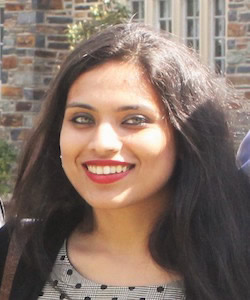
Does Religious Identity Matter for Economic Outcomes?
December 13, 2016
2016 Religious Freedom Project Fellows: Findings from the Field
How does ethnic identity affect economic outcomes such as employment and education? To answer this question, I examine various communities in India. In particular, I study the outcomes for Muslim women in relation to other ethnic groups of India, namely Hindu, Schedule Caste (SC), and Schedule Tribe (ST). A majority of the literature on economic exclusion in India has focused on caste-based discrimination, given the acute poverty and deprivation faced by lower caste communities in the country. However, despite being comparable on measures of economic, social, and educational deprivation, Indian Muslims have remained on the fringes of economic inquiry as well as development debates. Consequentially the policies and interventions for Muslims remain scarce and ill-defined.
The first chapter of my dissertation examines the changes in the labor force participation rate (LFPR) differences between women from the Hindu, Schedule Caste/Schedule Tribe (SC/ST), and Muslim communities in India, from 1983-1984 to 2011-2012. I divide the difference into two parts: the first part that can be explained by differences in education, household structure, regions, and other similar socioeconomic characteristics; the second part is the unexplained part that could potentially be due to differences in culture or labor market discrimination. With Hindus, as the reference community, I compare the differences in LFPR for Muslims and SC/ST. For the explained gap, I find that affirmative action policies have led to convergence in the education levels of Hindus and SC/ST, which has consequently led to a narrowing of the LFPR gap between the two groups over time. However, the Hindu-Muslim gap in female labor participation remains persistently high. The explained part of this gap, I find, is due to a majority of Muslim women living in regions of low economic development. Preliminary analysis of these regions reveals that the percentage of Muslims in both rural and urban areas is negatively correlated with female LFPR. The rest of my research will further examine such regional concentration empirically and also examine the unexplained part of the gap.
The role of culture has often been argued as one of the reasons for the relatively low socioeconomic position of Muslim women in India. On the other hand, the sociopolitical structures have also been identified to frequently and systematically disadvantage minority women on account of their religious identity and gender. My second chapter aims to investigate this culture question. My coauthor Dr. Maitreyi Bordia Das and I study the causes for large differences in female LFPR between West Bengal and Bangladesh. Until the independence of India and Pakistan in 1947 from British rule, the area that now covers West Bengal and Bangladesh was part of the larger Bengal presidency under colonial rule. The war of 1971 saw East Pakistan gain independence from Pakistan and embark on a new political journey as the country now known as Bangladesh. Both West Bengal and Bangladesh have undergone rapid economic and political changes over the last 68 years but retain a shared culture, language, history, and topography. Despite these commonalities, both regions exhibit very different levels of socioeconomic development, one of which is the wide disparity in female LFPR. The aim of this paper is twofold: firstly, we want to study what proportion of the LFPR differences between women from the two regions can be explained by differences in observable characteristics, and second, we want to know how much does religion matter in explaining these differences. We hypothesize that religion is an important determinant of attitude towards female work. In detail, we examine how Muslim women in either region behave when it comes to remunerative work, and how does education interact with religious identity to determine women’s likelihood of being employed.
Finally, my last chapter aims to study the causal impact of religious violence in India on the schooling and education decisions of Muslims in India. Religious identity has often been used as a tool for political polarization and exclusion. This exclusion manifests itself in the form of inter-group inequality, ghettoization and ethnic enclaves, and in extreme cases, violent conflict. The causes and consequences of violent conflict, particularly civil war, mass violence, and ethnic conflict, has attracted considerable scholarly attention across disciplines. However, there is much less research on how small isolated and geographically dispersed incidences of violence can lead to a long-term deficit in human capital accumulation for entire communities. This effect could be driven by the immediate loss of life and livelihood following the conflict. Such repeated conflict also ingrains a culture of fear in the minds of the affected community that may determine economic behavior in the long run. My paper looks at such an impact on education for Muslims using data on religious violence in India, covering the period between 1983 and 2014. Preliminary analysis shows that contemporaneous violence doesn’t have a significant impact on education decisions, but cumulative experience of violence has a small but measurable impact on education and dropout decisions of Muslim girls.
Using empirical analysis on various communities, especially the Muslims in India, my research up 'till now finds the religious identity to be a critical determinant of economic outcomes. This is a cause for worry, especially because my research is focused on the last three decades, a period during which the Indian economy witnessed rapid economic growth. Persistent differences in economic outcomes due to the religious identity not only questions the extent of economic inclusion of the Muslims of India, but also the extent to which the world’s largest democracy can pride itself on being a secular one.
About the Author
Opens in a new window
